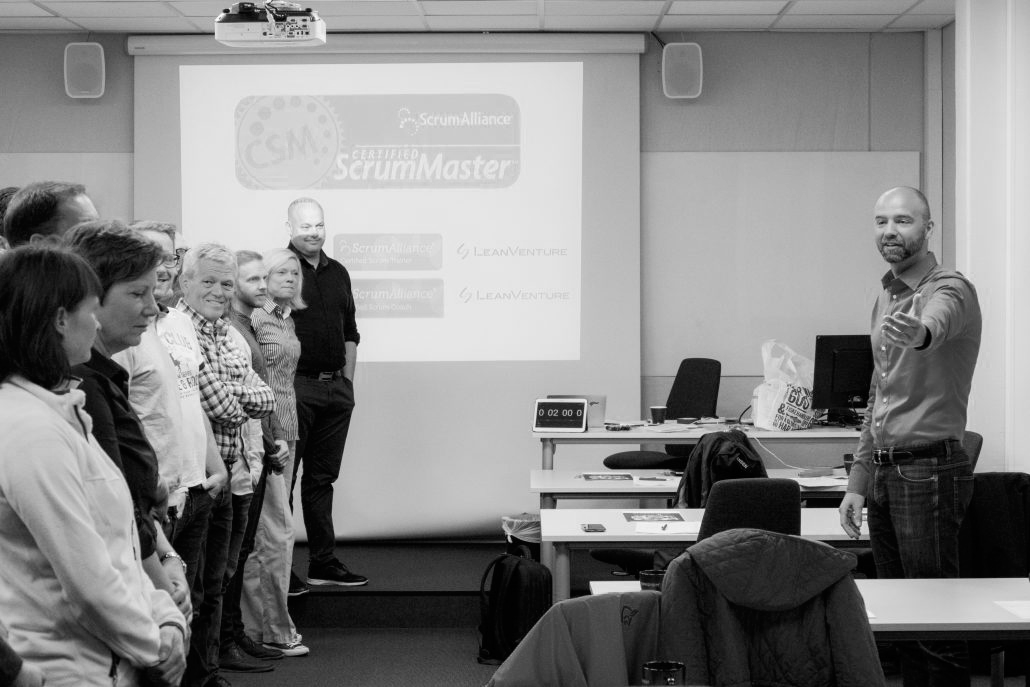Certified Scrum Product Owner (English)
This Certified Scrum Product Owner course provides knowledge of Scrum, focusing on the business- and customer side with an in-depth review of practical techniques for designing and prioritizing the Product Backlog. During this course you will learn everything you need to know about how the Product Owner role is defined and how you can implement this in your own organization. The course is highly interactive with exercises, lectures, group assignments, stories, and anecdotes from the Norwegian IT industry, as well as concrete in-class discussions. The trainer has extensive experience with the introduction of Scrum and other agile frameworks, and theories will help with practical examples.



Course excecution:
- The course is approved and recognized by Scrum Alliance and provides the certification Certified Scrum Product Owner
- Qualified English-speaking trainers
- Differing from other similar courses, we have chosen to set a limit of 25 participants for this course. This in order to ensure maximum quality and value to the delegates through dialogue and the possibility of raising concrete questions
Scope of the course:
- 2 hours mandatory preparatory e-learning course
- 2 full days of classroom teaching, both days from 09.00 - 16.30
Virtual (C2C) courses:
Glasspaper also offers virtual implementation of this course. Virtual course dates are labelled as "Virtual" in the order form. Both course days will be carried out over the Zoom platform, as well as Google Docs.
Audience:
Product Owners, managers and others responsible for creating customer and organizational values.
Prerequisites:
None, but we reccommend having a basic understanding of Scrum and to review one of the following:
Contents / Course Outline:
1. An understanding of the definition of Scrum and the principles and values constituting this
- Inspiration from “The New New Product Development Game”, "The Toyota Way" and Lean: Just-in-time principle, Pull principle, Eliminate Waste and Deliver Fast
- Create a learning organization
- The Scrum position within the organization
- Quality and Technical debt
2. Understanding Empirical Process Management. Scrum rests on the principles of:
- Transparency (how to ensure that obstacles come to be visible)
- Inspection (how to understand the obstacles we are observering)
- Adaptation (how to act to remove obstacles and ensure improvements)
3. An understanding of all roles, with a particular focus on The Product Owners areas of responsibility:
- To establish clear product targets for the investments so everyone understands the effects of the product. Who are we aiming to satisfy and what are their needs
- To ensure a well-established prduct goal in the organization
- Have ongoing communication with stakeholders so changes in needs and priorities are captured
- Preparation of an estimated and arranged Product Backlog
- To conduct a Sprint Planning Meeting as the first part of each iteration
- To communicate well with the Developers
- To ensure good feedback from the right stakeholders at the end of each iteration (Sprint Review)
- Continuous cost/benefit assessments to ensure the Team are working with what generates the greatest value at all times
- To release planning- and aceptance testing
4. Laying down a strategy and plans flexible to change
- To use Product Backlog Refinement to roughly estimate the items in the product queue
- To use cost/benefit assessments as a basis for priorities
- To use relative estimation and Planning Poker
- To respect the developers' estimates without adding external pressure
- To create a release plan and preferably a rough Product Roadmap
- To set good Sprint targets that represent steps towards the Product Target
- To develop Product Backlog in collaboration with the stakeholders and the Scrum Team
5. To maximize the product's market value
- The strengths of continuous prioritization
- Open, visible prioritization - strengths and challenges
- The use of mental models, such as the Kano-model, MoSoW etc.
- To identify minimal "bulks" of functionality (“Minimal Marketable Features”, “Minimal Viable Product”)
- To utilize concepts such as “Job-to-be-done”, “Value Proposition Canvas” and “Lean Canvas”
- The technique “User Story Mapping”
- To assess short-term vs. long-term needs
6. To understand release management
- The value of frequent releases and "real" feedback from the market
- The value of committing at the last moment of responsibility
- The value of a clear and correct definition of the word "Done" (Definition of Done - DoD)
- To understand the concept of technical debt
- To learn how to utilize the teams history of velocity
- To create long-term plans based on velocity with a realistic view of uncertainties
7. To create the strengths of the iterations (Sprints)
- The value of the developers committing - and working undisturbed towards the Sprint target
- The value of rythm and holding the Sprint constant over time
- To execute good Sprint Planning meetings
- To execute good Sprint Review meetings
- To execute good Spring Retrospective meetings
Certification
This course is a certification course - after completion and approved course you will receive the title "Certified Scrum Product Owner".
Geir Amsjø, Certified Scrum Trainer
Norges første Certified Scrum Trainer: Agile Coach. Geir har mer enn 20 års erfaring fra IT-bransjen i mange ulike roller: Utvikling, prosjektledelse, test, kvalitetssikring og linjeledelse for å nevne noen. Metodikk og prosessforbedring har alltid vært hovedinteressen, og siden 2003 har fokus utelukkende vært på smidig systemutvikling og Lean. Geir er en svært erfaren kursholder og har veiledet/coachet en rekke norske selskaper innen smidig.
Benjamin Sommer, Certified Scrum Trainer and Certified Enterprise Coach
Benjamin is a professional agile coach, trainer and innovation mentor. Benjamin is recognised worldwide as an expert in Agile and Scrum and he holds the two highest-level certifications in the field: CST (Certified Scrum Trainer) and CEC (Certified Enterprise Coach) by the Scrum Alliance. His focus is on helping organisations achieve business agility, make product teams go faster and deliver more value. Benjamin has more than 20 years experience as business developer, management consultant, entrepreneur and investor.







